The vast stretches of the prairie, once a sea of waving grasslands, now lay eerily still. The Silent Howl of the Disappearing Prairie captures a tale of loss, a chronicle of silence that ensues when the lifeblood of an ecosystem dries out. This bleak vista, an endless barren terrain, tells a story not with the abundance of life it once did, but through absence and the ghostly whispers of what was.
Cast your eyes upon this scorched earth where buffaloes roamed in thunderous herds and the plaintive calls of meadowlarks once painted the air. In their place, the wind now carves shallow grooves on the cracked soil, a solemn artist working on a canvas of despair. The unrelenting sun beats down upon the broken ground where the roots of blue grama and buffalo grass fought bravely but in vain against the tightening vise of human-induced climate change.
What wrought this transformation? The culpable hands of environmental neglect are uncovered in layers, from the carbon-choked skies that heralded droughts to the water-thirsty industries that sapped the rivers dry. And then came the infernos, leaping and roaring through the grass, leaving behind a charred testimony to our follies.
As we delve deeper into this solemn narrative, we encounter the absent denizens of this lost world. The prairie dogs, those industrious little architects, have abandoned their towns. The swift fox, agile and sharp, has vanished, unable to outrun the desolation. Rattlesnakes, once kings of venomous rule, now lay as dry as the earth beneath a blistering sun.
The plight of the prairie is not always silent, though. Sometimes, humanity’s own echoes rebound against the bleakness. Abandoned farmhouses crumble, their weathered timbers groaning under the weight of neglect. Rusty tractors stand as monuments to a time when the soil promised bounty instead of dust. ‘What have we done?’ is a question that manifests not in words, but in the haunting vacancy of human habitation swallowed by the advancing ruin.
Yet in the throes of this somber reflection, there exists a strange pull, a fascination that tugs at the soul. The remnants of wildflowers, stubborn in their withered beauty, still claim their space among the ruins. Even in decline, there is a twisted allure to the starkness, a seductive call to bear witness to an apocalypse of our own making. It is this paradoxical beauty, wrapped in devastation, that forces us to confront the reality we have sown.
The story of the disappearing prairie goes beyond an environmental catastrophe; it is a narrative that intertwines with the very threads of our humanity — our legacy, our future, our conscience. In this near-silent world where the howl of the wolf has been replaced by the howl of the void, the message is clear: these prairies are but a mirror, reflecting the potential fate of myriad ecosystems across our planet.
Finally, we ask ourselves, where do we stand within this tale of decay? As readers ensnared by the daunting beauty that lies within destruction, we are left to ponder our role in the dance of creation and destruction. Will we step gracefully or continue to tread heavily upon this fragile earth?
The silence of the prairie is a harrowing portent, a siren’s song luring us towards the rocky shores of irreversible ruin. Do we dare to navigate away, or will we succumb to the lulling hum of apathy and let the remaining vestiges of life’s symphony fade into a silent howl?
